Experimental Study on the Detection of the Existence and Location of Mimicked and Unexpected Interface Debonding Defects in an Existing Rectangular CFST Column with PZT Materials
Abstract
:1. Introduction
2. Principle of Interface Debonding Defect Detection with Surface Wave and EMI Measurements
2.1. Detection of Interface Debonding along the Surface Wave Propagation Path from a Surface Mounted PZT Actuator to a Sensor
2.2. Interface Debonding Localization Using EMI as a Local Method
3. Experimental Study on Preliminary Interface Debonding Detection with Surface Wave Measurement
3.1. Rectangular CFST Specimen and Experiment Scheme
3.2. Excitation Signals
3.3. Analysis of Output Voltage of Surface-Mounted PZT Sensor Measurements
4. Experimental Study for Detailed Interface Debonding Localization Detection with EMI Measurements
4.1. EMI Measurement System
4.2. Impedance Signal Analysis of the CFST Specimen with Mimicked Interface Debonding Defects
5. Conclusions
- To quickly and efficiently judge the interface bonding condition and preliminarily determine the regions of interface debonding defects, surface wave measurements were made with the help of PZT sensors and actuators installed on the outer surface of the rectangular CFST specimen. Experimental results showed that the energy of the stress wave propagating from the steel tube to the concrete core decreased due to the existence of interface debonding between the PZT actuator and sensor. Therefore, the energy of the surface wave propagating in the steel tube between the PZT actuator and sensor in the surface wave travelling path with an interface debonding defect was greater than that without interface debonding defects under the excitation of either a continuous sinusoidal signal or a 10-period sinusoidal windowed signal. The existence of three interface debonding defects corresponding to three surface wave travelling paths, A4–A5, C1–C2, and D2–D3, were preliminarily identified by analyzing the changes in the signal amplitude of the surface wave measured by PZT sensors in different surface wave travelling paths.
- To further accurately determine the location of the unknown interface debonding defects in the specimen, additional surface-mounted PZT sensors were installed in the preliminary determined interface debonding defect regions for EMI measurement. The EMI measurements were compared, and the test results showed that the EMI curves at the measurement points of A4–5, C1–2, and D2–3 were significantly different from those at other measurement points at determined healthy regions. The EMI measurement at healthy regions were close to each other. The measurement points of A4–5, C1–2, and D2–3 can be judged as the locations of the mimicked defects.
- To verify the accuracy of the debonding defect detection results using both surface wave and EMI measurements for the rectangular CFST member with unknown interface debonding defects, a destructive observation was carried out by cutting the outer steel tube at the locations of the identified interface debonding defects. The observation results showed that actual interface debonding defects existed at the three detected interface debonding defect locations. Among the three detected interface debonding defects, the interface debonding defects at measurement points of C1–2 and D2–3 matched well with the actual artificially mimicked interface debonding defects, and the interface debonding defect at the measurement point A4–5 was unexpected because no artificially mimicked interface debonding was installed there. The existence of the defect at point A4–5 may have been caused by concrete shrinkage after the placement of the specimen in a lab for over one year.
- Experimental results showed that the proposed method can perform NDT for the detecting and localizing of interface debonding defects in rectangular CFST components rapidly and efficiently with PZT actuating and sensing technology. In practical engineering application, the dimensions of CFST columns are typically larger. On the basis of ensuring the accuracy of the interface debonding detection results, the layout of PZT sensors should be optimized. Moreover, a comprehensive investigation on the influence of internal ring plates and anchor bolts on stress wave propagation and EMI measurements should be carried out in the future.
Author Contributions
Funding
Institutional Review Board Statement
Informed Consent Statement
Data Availability Statement
Conflicts of Interest
References
- Nematzadeh, M.; Fazli, S.; Naghipour, M.; Jalali, J. Experimental study on modulus of elasticity of steel tube-confined concrete stub columns with active and passive confinement. Eng. Struct. 2017, 130, 142–153. [Google Scholar] [CrossRef]
- Xue, J.; Zhang, Y.; Briseghella, B.; Chen, B. Experimental research on effects of debonding on circular CFST columns with different slenderness ratios. In Proceedings of the 9th International Conference on Arch Bridges, Porto, Portugal, 2–4 October 2019; pp. 369–377. [Google Scholar]
- Wang, X.L.; Fan, F.F.; Lai, J.X. Strength behavior of circular concrete-filled steel tube stub columns under axial compression: A review. Constr. Build. Mater. 2022, 322, 126–144. [Google Scholar] [CrossRef]
- Wang, F.C.; Xie, W.Q.; Li, B.; Han, L.H. Experimental study and design of bond behavior in concrete-filled steel tubes (CFST). Eng. Struct. 2022, 268, 114750. [Google Scholar] [CrossRef]
- Li, L.; Jiao, J.P.; Gao, X.; Jia, Z.H.; Wu, B.; He, C.F. A review on nondestructive testing of bonding interface using nonlinear ultrasonic technique. Chin. Sci. B-Chin. 2022, 67, 621–629. (In Chinese) [Google Scholar] [CrossRef]
- Chen, D.D.; Wang, L.W.; Luo, X.J.; Fei, C.L.; Li, D.; Shan, G.B.; Yang, Y.T. Recent development and perspectives of optimization design methods for piezoelectric ultrasonic transducers. Micromachines 2021, 12, 779. [Google Scholar] [CrossRef] [PubMed]
- Li, Z.; Haigh, A.D.; Saleh, M.N.; McCarthy, E.D.; Soutis, C.; Gibson, A.A.P.; Sloan, R. Detection of impact damage in carbon fiber composites using an electromagnetic sensor. Res. Nondestruct. Eval. 2018, 29, 123–142. [Google Scholar] [CrossRef]
- Moll, J. Guided electromagnetic waves for damage detection and localization in metallic plates: Numerical and experimental results. Int. J. Microw. Wirel. Technol. 2020, 12, 455–460. [Google Scholar] [CrossRef]
- Li, D.S.; Zhou, J.L.; Ou, J.P. Damage, nondestructive evaluation and rehabilitation of FRP composite-RC structure: A review. Constr. Build. Mater. 2020, 271, 121551. [Google Scholar] [CrossRef]
- Hamzeloo, S.R.; Shamshirsaz, M.; Rezaei, S.M. Damage detection on hollow cylinders by electro-mechanical impedance method: Experiments and finite element modeling. Comptes Rendus Mécanique 2012, 340, 668–677. [Google Scholar] [CrossRef]
- Liu, Q.; Xu, B.; Xia, Z.J.; Yao, Y.D.; Wang, J. Interface debonding defect detection for CFST columns based on EMI measurements: Experiment, numerical simulation and blind inspection in practice. Adv. Struct. Eng. 2024, 27, 1151–1169. [Google Scholar] [CrossRef]
- Liang, C.; Sun, F.P.; Rogers, C.A. Coupled electro-mechanical analysis of adaptive material systems-determination of the actuator power consumption and system energy transfer. J. Intell. Mater. Syst. Struct. 1994, 5, 12–20. [Google Scholar] [CrossRef]
- Selva, P.; Cherrier, O.; Budinger, V.; Lachaud, F.; Morlier, J. Smart monitoring of aeronautical composites plates based on electromechanical impedance measurements and artificial neural networks. Eng. Struct. 2013, 56, 794–804. [Google Scholar] [CrossRef]
- Kocherla, A.; Duddi, M.; Subramaniam, K.V.L. Embedded PZT sensors for monitoring formation and crack opening in concrete structures. Measurement 2021, 182, 109698. [Google Scholar] [CrossRef]
- Moslehy, Y.; Gu, H.C.; Belarbi, A.; Mo, Y.L.; Song, G.B. Smart aggregate based damage detection of circular RC columns under cyclic combined loading. Smart. Mater. Struct. 2010, 19, 065021. [Google Scholar] [CrossRef]
- Markovic, N.; Nestorovic, T.; Stojic, D. Numerical modeling of damage detection in concrete beams using piezoelectric patches. Mech. Res. Commun. 2015, 64, 15–22. [Google Scholar] [CrossRef]
- Xu, B.; Li, B.; Song, G.B. Active debonding detection for large rectangular CFSTs based on wavelet packet energy spectrum with piezoceramics. J. Struct. Eng. 2013, 139, 1435–1443. [Google Scholar] [CrossRef]
- Xu, B.; Chen, H.B.; Xia, S. Wave propagation simulation and its wavelet package analysis for debonding detection of circular CFST members. Smart. Struct. Syst. 2017, 19, 181–194. [Google Scholar] [CrossRef]
- Xu, B.; Chen, H.B.; Mo, Y.L.; Chen, X.M. Multi-physical field guided wave simulation for circular concrete-filled steel tubes coupled with piezoelectric patches considering debonding defects. Int. J. Solids Struct. 2017, 122, 25–32. [Google Scholar] [CrossRef]
- Xu, B.; Luan, L.L.; Chen, H.B.; Ge, H.B. Numerical study on interface debonding detection mechanisms with 2d spectral element method for concrete-filled steel tube using embedded PZT sensor. Smart Mater. Struct. 2018, 27, 125008. [Google Scholar] [CrossRef]
- Xu, B.; Luan, L.L.; Chen, H.B.; Wang, H.D. Local wave propagation analysis in concrete-filled steel tube with spectral element method using absorbing layers—Part I: Approach and validation. Mech. Syst. Signal Proc. 2020, 140, 106644. [Google Scholar] [CrossRef]
- Luan, L.L.; Xu, B.; Chen, H.B.; Wang, H.D. Local wave propagation analysis in concrete-filled steel tubes with spectral element method using absorbing layers—Part II: Application in coupling system. Mech. Syst. Signal Proc. 2021, 146, 107004. [Google Scholar] [CrossRef]
- Xu, B.; Chen, H.B.; Mo, Y.L.; Zhou, T.M. Dominance of debonding defect of CFST on PZT sensor response considering the meso-scale structure of concrete with multi-scale simulation. Mech. Syst. Signal Proc. 2018, 107, 515–528. [Google Scholar] [CrossRef]
- Wang, J.; Xu, B.; Liu, Q.; Guan, R.Q.; Ma, X. Feasibility of stress wave-based debond defect detection for RCFSTs considering the influence of randomly distributed circular aggregates with mesoscale homogenization methodology. Materials 2023, 16, 3120. [Google Scholar] [CrossRef] [PubMed]
- Lee, F.W.; Lim, K.S.; Chai, H.K. Determination and extraction of Rayleigh-waves for concrete cracks characterization based on matched filtering of center of energy. J. Sound Vibr. 2016, 363, 303–315. [Google Scholar] [CrossRef]
- Xu, B.; Luan, L.L.; Chen, H.B.; Wang, J.; Zheng, W.T. Experimental study on active interface debonding detection for rectangular concrete-filled steel tubes with surface wave measurement. Sensors 2019, 19, 3248. [Google Scholar] [CrossRef] [PubMed]
- Chen, H.B.; Xu, B.; Wang, J.; Luan, L.L.; Zhou, T.M.; Nie, X.; Mo, Y.L. Interfacial debonding detection for rectangular CFST using the MASW method and its physical mechanism analysis at the meso-level. Sensors 2019, 19, 2778. [Google Scholar] [CrossRef] [PubMed]
- Chen, H.B.; Xu, B.; Zhou, T.M.; Mo, Y.L. Debonding detection for rectangular CFST using surface wave measurement: Test and multi-physical fields numerical simulation. Mech. Syst. Signal Proc. 2019, 117, 238–254. [Google Scholar] [CrossRef]
- Ma, X.S.; Bian, K.; Lu, J.; Xiong, K. Experimental research on detection for interface debond of CFRP T-joints under tensile load. Compos. Struct. 2016, 158, 359–368. [Google Scholar] [CrossRef]
- Na, W.S.; Baek, J. A review of the piezoelectric electromechanical impedance based structural health monitoring technique for engineering structures. Sensors 2018, 18, 1307. [Google Scholar] [CrossRef]
- Fan, X.; Li, J.; Hao, H. Impedance resonant frequency sensitivity based structural damage identification with sparse regularization: Experimental studies. Smart Mater. Struct. 2019, 28, 015003. [Google Scholar] [CrossRef]
- Liaqat, A.; Sikandar, K.; Naveed, I.; Salem, B.; Hamad, H.; Yong, B. An experimental study of damage detection on typical joints of jackets platform based on electro-mechanical impedance technique. Materials 2021, 14, 7168. [Google Scholar] [CrossRef] [PubMed]
- Zuo, C.Y.; Feng, X.; Zhang, Y.; Lu, L.; Zhou, J. Crack detection in pipelines using multiple electromechanical impedance sensors. Smart Mater. Struct. 2017, 26, 104004. [Google Scholar] [CrossRef]
- Wang, T.; Tan, B.H.; Lu, M.G.; Zhang, Z.; Lu, G.T. Piezoelectric electro-mechanical impedance (EMI) based structural crack monitoring. Appl. Sci. 2020, 10, 4648. [Google Scholar] [CrossRef]
- Li, W.J.; Wang, J.J.; Liu, T.J.; Luo, M.Z. Electromechanical impedance instrumented circular piezoelectric-metal transducer for corrosion monitoring: Modeling and validation. Smart. Mater. Struct. 2020, 29, 035008. [Google Scholar] [CrossRef]
- Mascarenas, D.L.; Todd, M.D.; Park, G.; Farrar, C.R. A miniaturized electromechanical impedance-based node for the wireless interrogation of structural health. In Proceedings of the Health Monitoring and Smart Nondestructive Evaluation of Structural and Biological Systems, San Diego, CA, USA, 26 February–2 March 2006; Volume 6177. [Google Scholar]
- Le, T.C.; Ho, D.D.; Huynh, T.C. Anchor force monitoring using impedance technique with single-point mount lead-zirconate-titanate interface: A feasibility study. Buildings 2021, 11, 382. [Google Scholar] [CrossRef]
- Park, G.; Cudney, H.H.; Inman, D.J. Feasibility of using impedance-based damage assessment for pipeline structures. Earthq. Eng. Struct. Dyn. 2001, 30, 1463–1474. [Google Scholar] [CrossRef]
- Na, S.; Tawie, R.; Lee, H.K. Electromechanical impedance method of fiber-reinforced plastic adhesive joints in corrosive environment using a reusable piezoelectric device. J. Intel. Mat. Syst. Str. 2012, 23, 737–747. [Google Scholar] [CrossRef]
- Ai, D.M.; Cheng, J. A deep learning approach for electromechanical impedance based concrete structural damage quantification using two-dimensional convolutional neural network. Mech. Syst. Signal Proc. 2023, 183, 109634. [Google Scholar] [CrossRef]
- Kamal, A.; Shweta, G.; Sudhakara, R.M. Crack healing in concrete by microbially induced calcium carbonate precipitation as assessed through electromechanical impedance technique. Eur. J. Environ. Civ. Eng. 2023, 27, 1123–1143. [Google Scholar]
- Ai, D.M.; Lin, C.; Zhu, H.P. Embedded piezoelectric transducers based early-age hydration monitoring of cement concrete added with accelerator/retarder admixtures. J. Intel. Mat. Syst. Str. 2021, 32, 847–866. [Google Scholar] [CrossRef]
- Tawie, R.; Lee, H.K. Monitoring the strength development in concrete by EMI sensing technique. Constr. Build. Mater. 2010, 24, 1746–1753. [Google Scholar] [CrossRef]
- Su, Y.F.; Han, G.S.; Nantung, T.; Lu, N. Novel methodology on direct extraction of the strength information from cementitious materials using piezo-sensor based electromechanical impedance (EMI) method. Constr. Build. Mater. 2020, 259, 119848. [Google Scholar] [CrossRef]
- Kuang, J.; Xu, B. Local damage detection for steel rebar by impedance measurements of PZT sensors. In Proceedings of the Third International Conference on Smart Materials and Nanotechnology in Engineering, Shenzhen, China, 11–13 November 2011. [Google Scholar]
- Nguyen, T.H.; Phan, T.T.V.; Le, T.C.; Ho, D.D.; Huynh, T.C. Numerical simulation of single-point mount PZT-interface for admittance-based anchor force monitoring. Buildings 2021, 11, 550. [Google Scholar] [CrossRef]
- Su, Y.F.; Han, G.; Kong, Z.; Nantung, T.; Lu, N. Embeddable piezoelectric sensors for strength gain monitoring of cementitious materials: The influence of coating materials. Eng. Sci. 2020, 11, 66–75. [Google Scholar] [CrossRef]
- Baptista, F.G.; Budoya, D.E.; de Almeida, V.A.D.; Ulson, J.A.C. An experimental study on the effect of temperature on piezoelectric sensors for impedance-based structural health monitoring. Sensors 2014, 14, 1208–1227. [Google Scholar] [CrossRef] [PubMed]
- Fan, X.; Li, J. Damage identification in plate structures using sparse regularization based electromechanical impedance technique. Sensors 2020, 20, 7069. [Google Scholar] [CrossRef] [PubMed]
- Voutetaki, E.M.; Papadopoulos, A.N.; Angeli, M.G.; Providakis, C.P. Investigation of a new experimental method for damage assessment of RC beams failing in shear using piezoelectric transducers. Eng. Struct. 2016, 114, 226–240. [Google Scholar] [CrossRef]
- Divsholi, B.S.; Yang, Y.W.; Bing, L. Monitoring beam-column joint in concrete structures using piezo-impedance sensors. Adv. Mater. Res. 2009, 79, 59–62. [Google Scholar] [CrossRef]
- Kaur, H.; Singla, S. A Parametric study of the impact of crack parameters on EMI response in RC beams using correlation analysis. J. Vib. Eng. Technol. 2024, 1–15. [Google Scholar] [CrossRef]
- Ai, D.M.; Zhang, D.L.; Zhu, H.P. Damage localization on reinforced concrete slab structure using electromechanical impedance technique and probability-weighted imaging algorithm. Constr. Build. Mater. 2024, 424, 424135824. [Google Scholar] [CrossRef]
- Luan, L.L.; Xu, B.; Chen, H.B. Numerical simulation on stress wave propagation of steel-concrete composite structures with interface debonding by spectral element method. Eng. Mech. 2017, 34, 145–152. (In Chinese) [Google Scholar]
- Wang, D.S.; Song, H.Y.; Zhu, H.P. Numerical and experimental studies on damage detection of a concrete beam based on PZT admittances and correlation coefficient. Constr. Build. Mater. 2013, 49, 564–574. [Google Scholar] [CrossRef]
- Karayannis, C.G.; Golias, E.; Naoum, M.C.; Chalioris, C.E. Efficacy and damage diagnosis of reinforced concrete columns and joints strengthened with FRP ropes using piezoelectric transducers. Sensors 2022, 21, 8294. [Google Scholar] [CrossRef] [PubMed]
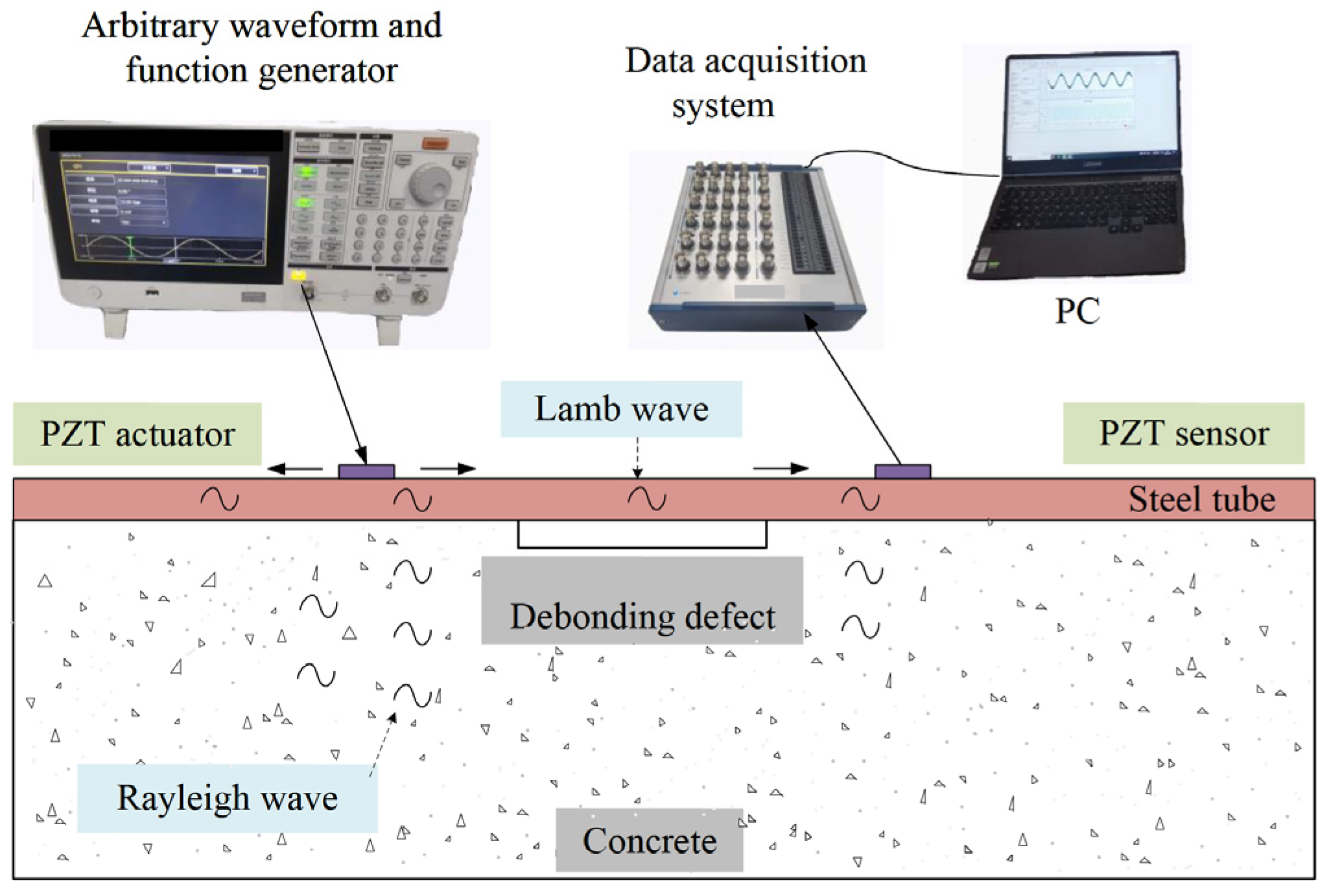
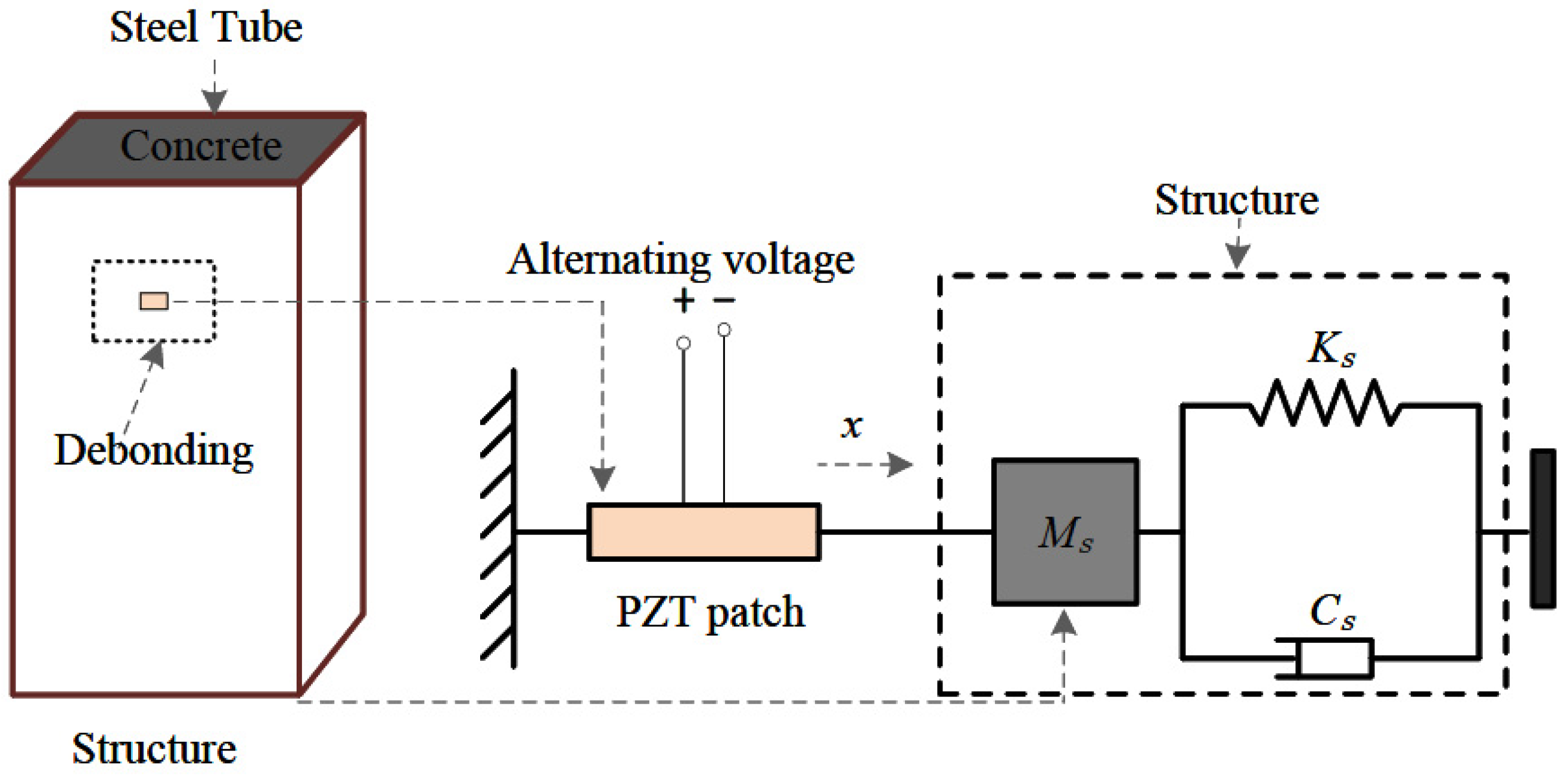
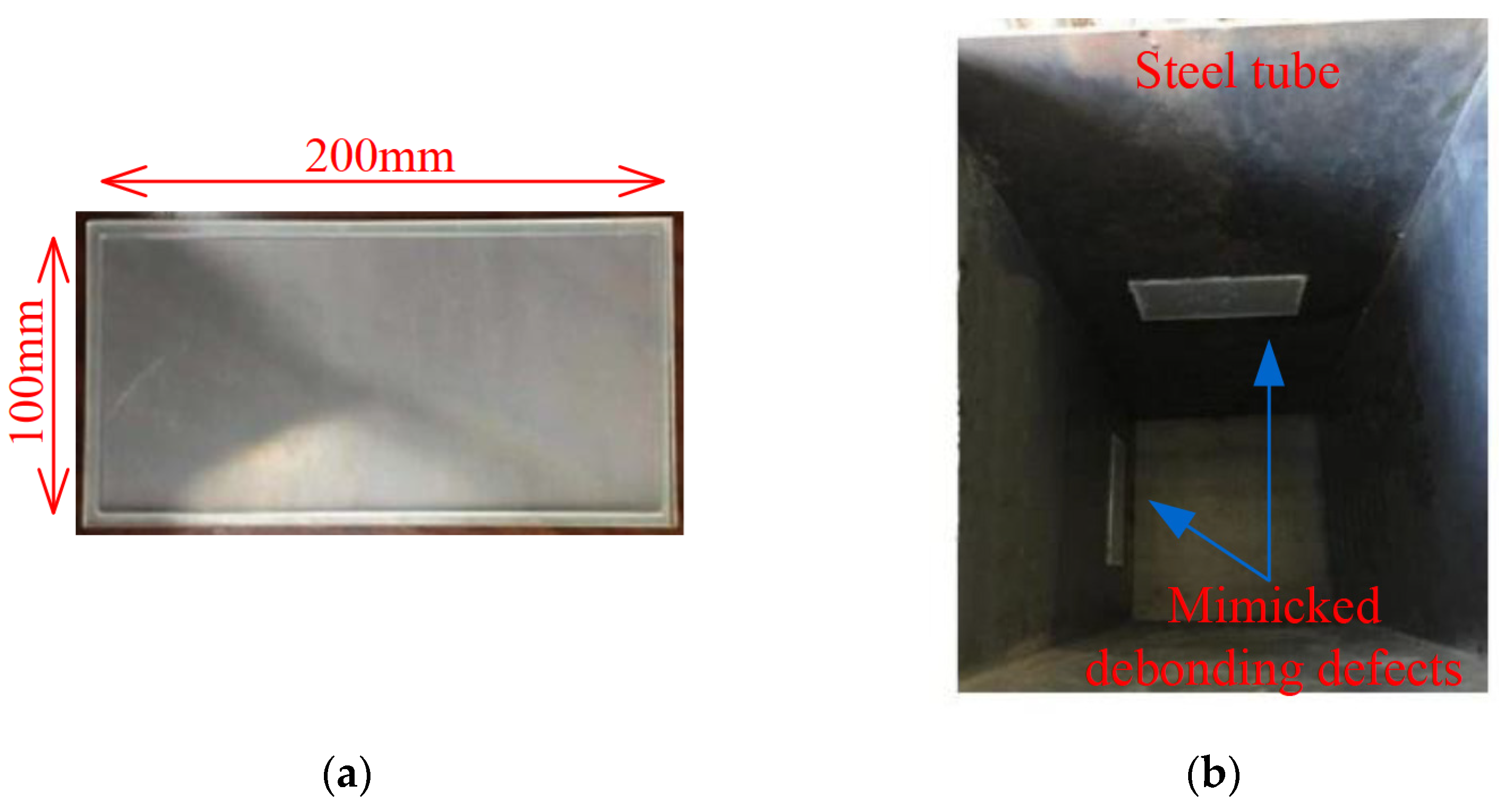
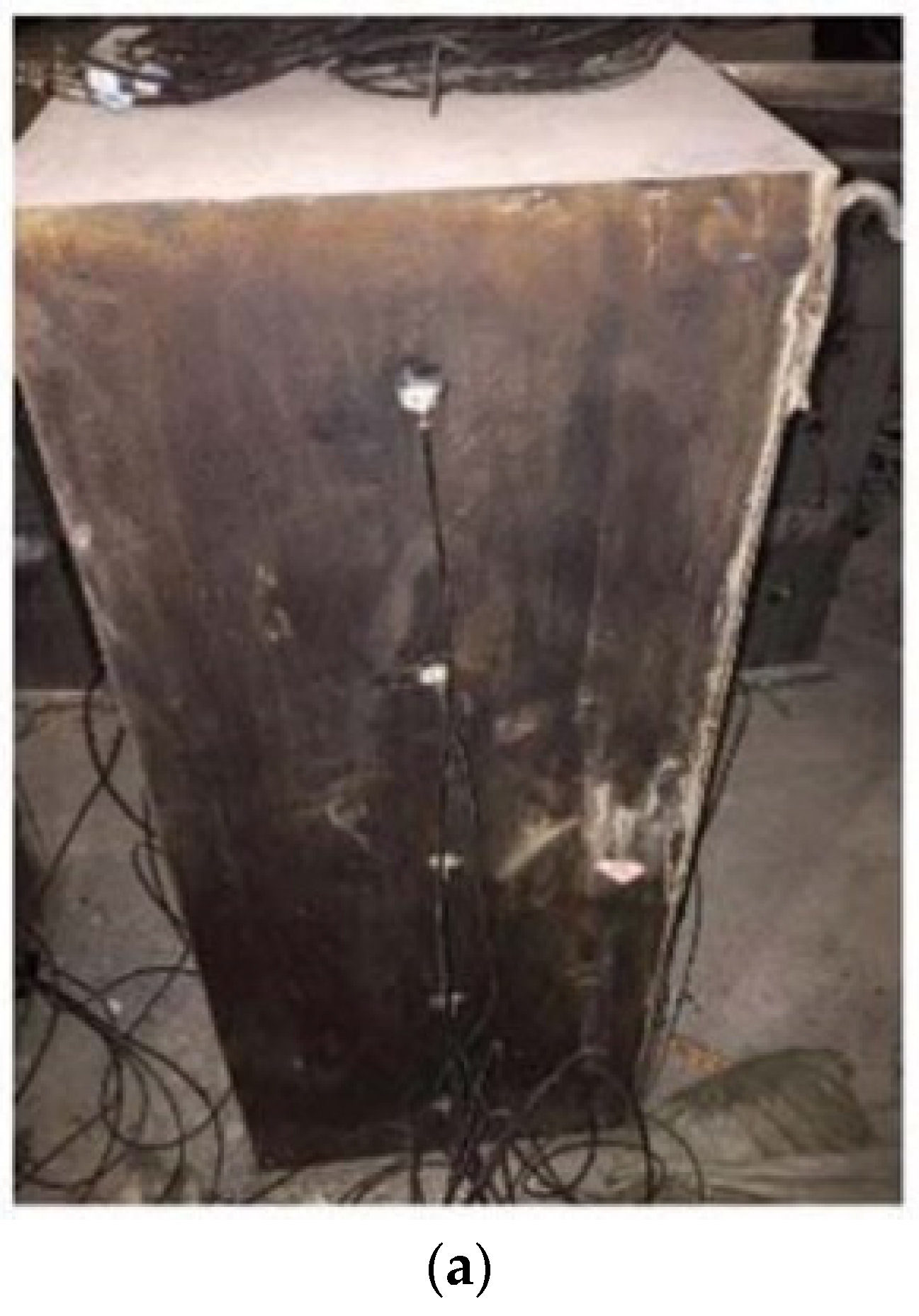
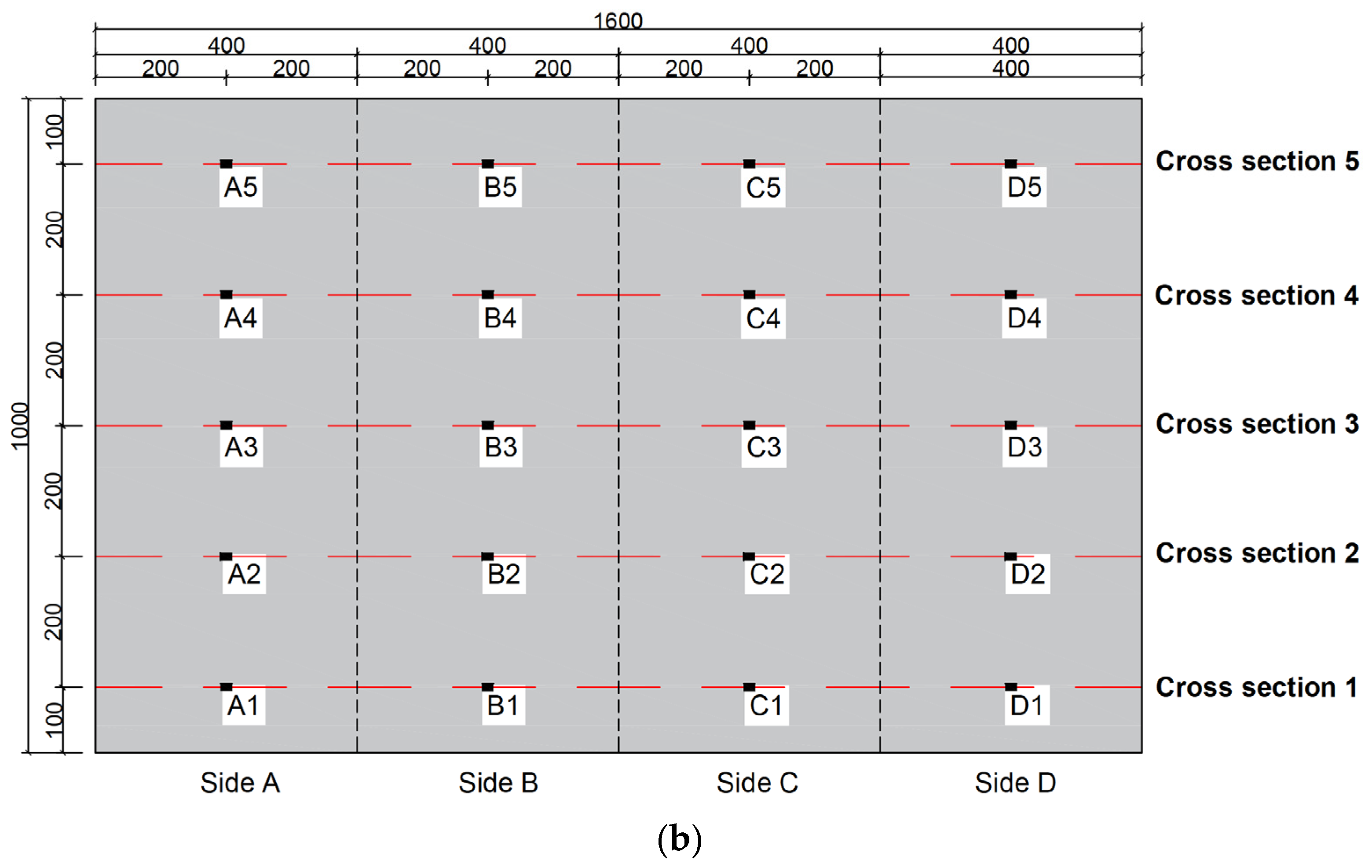
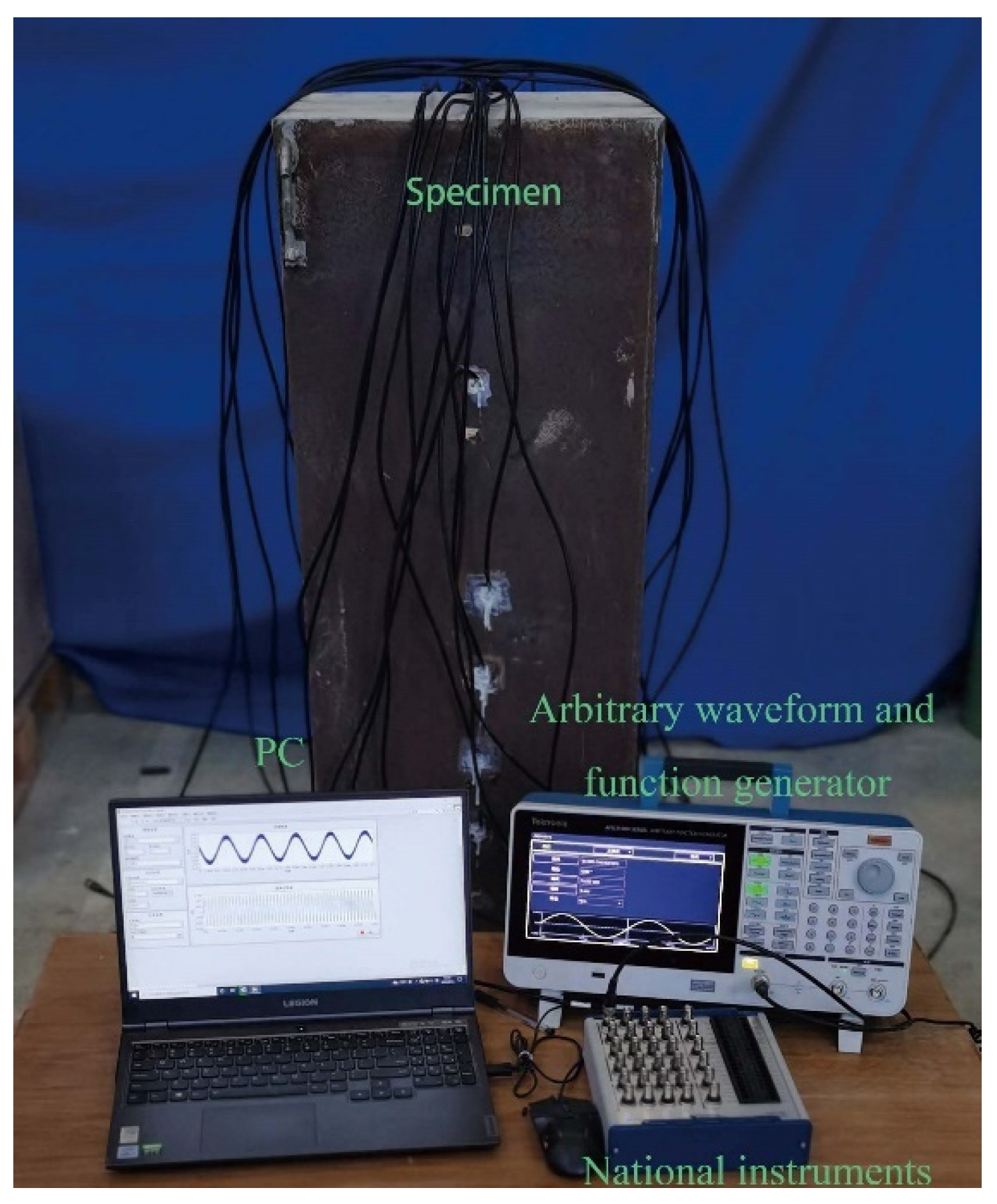

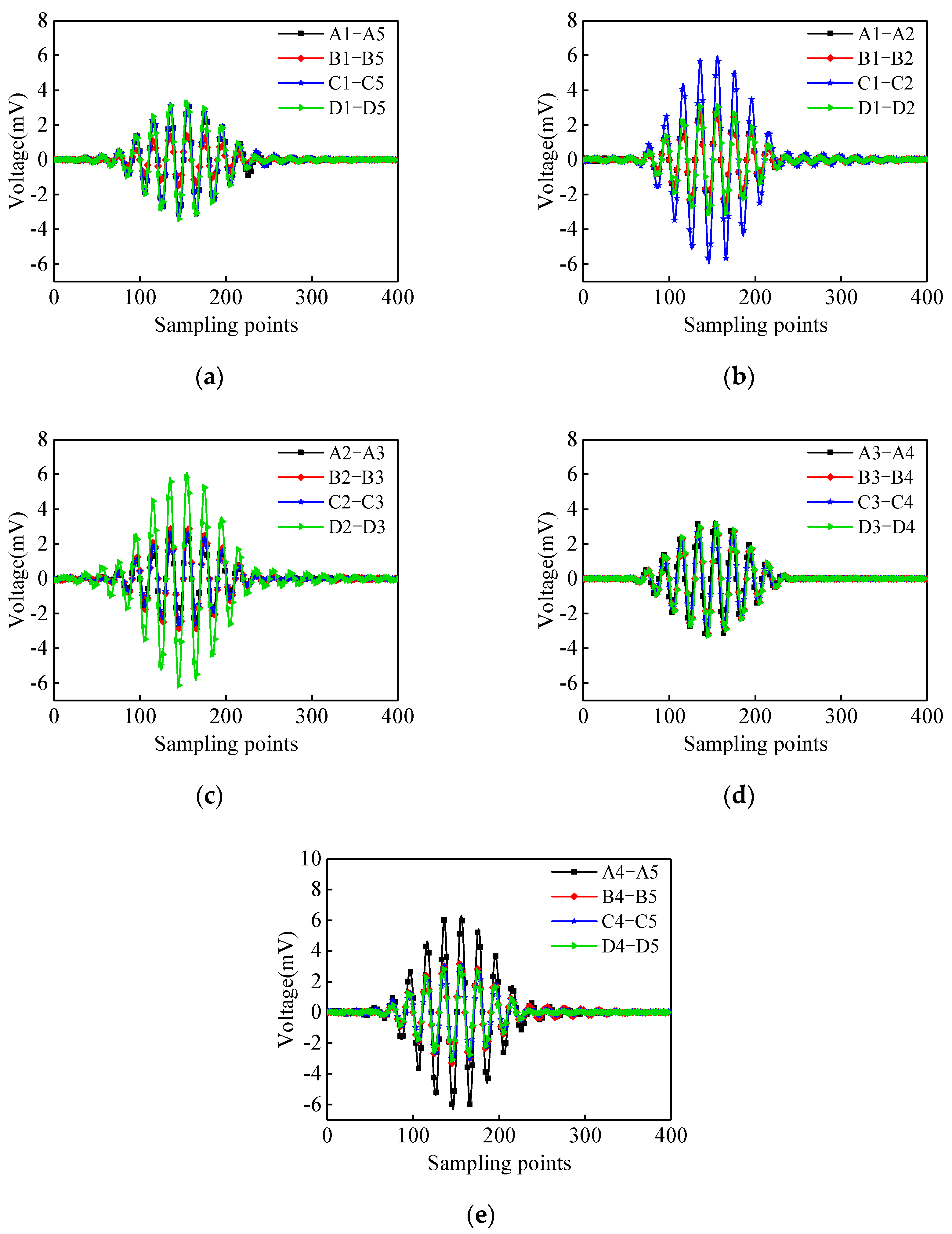
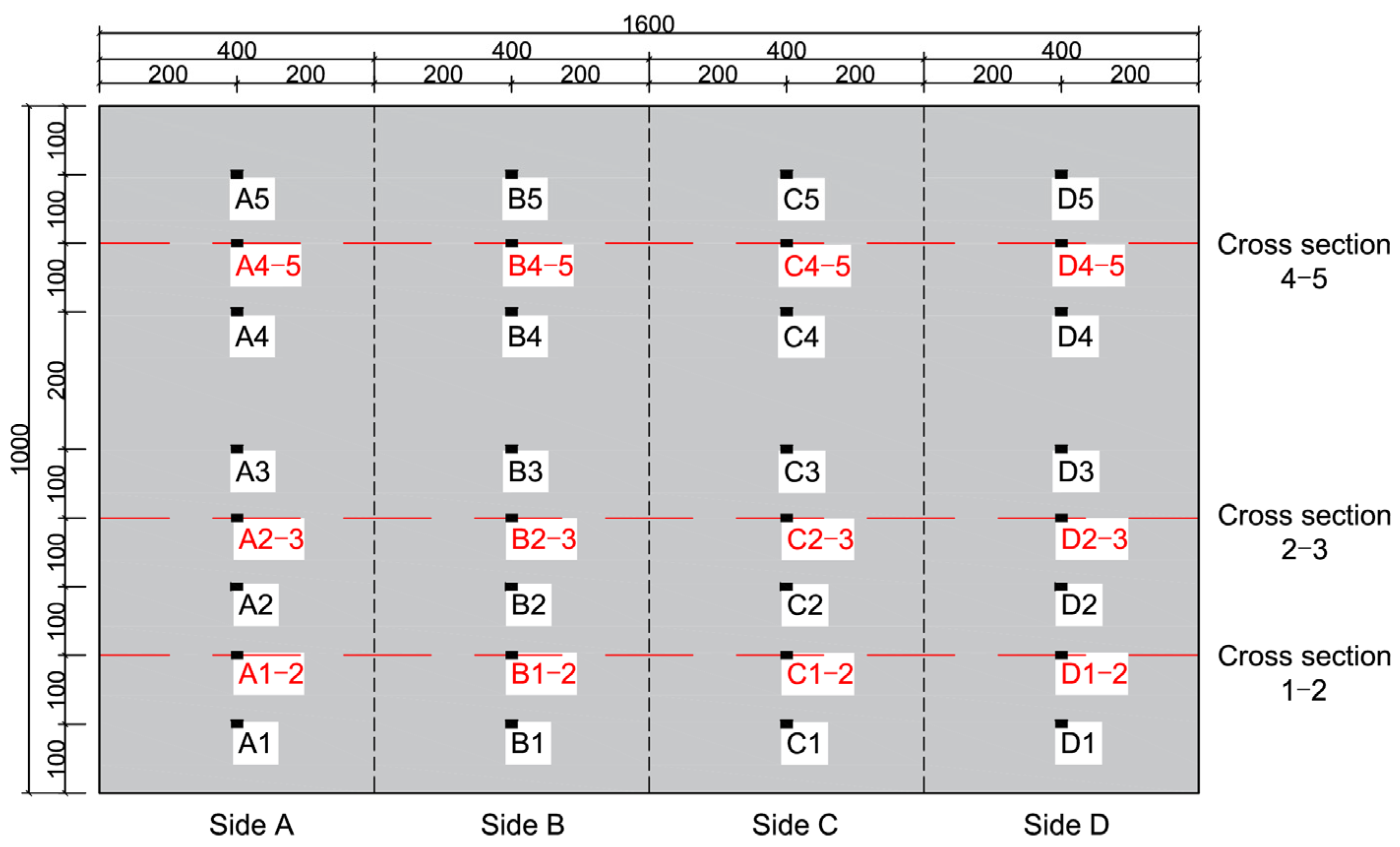
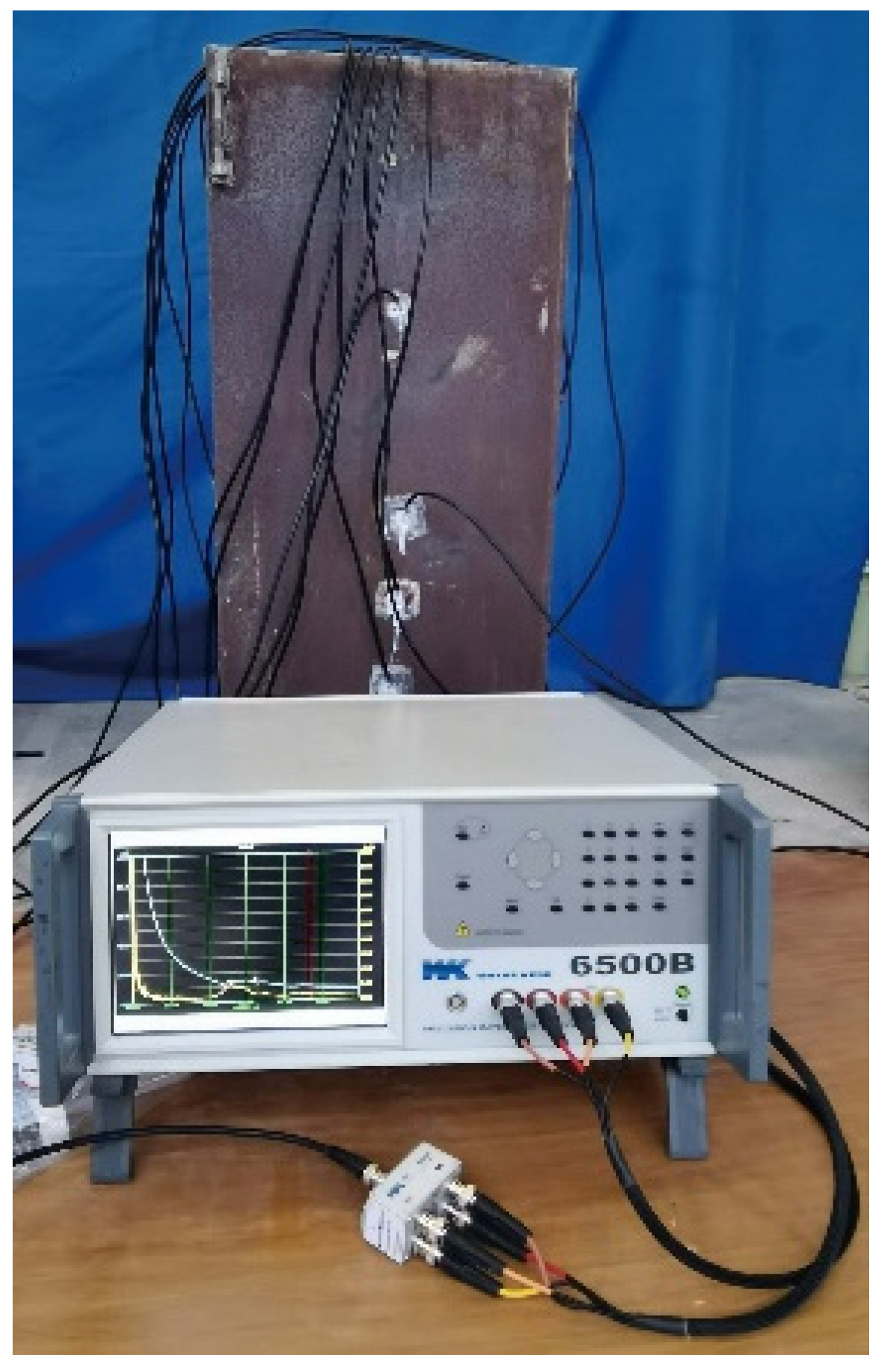
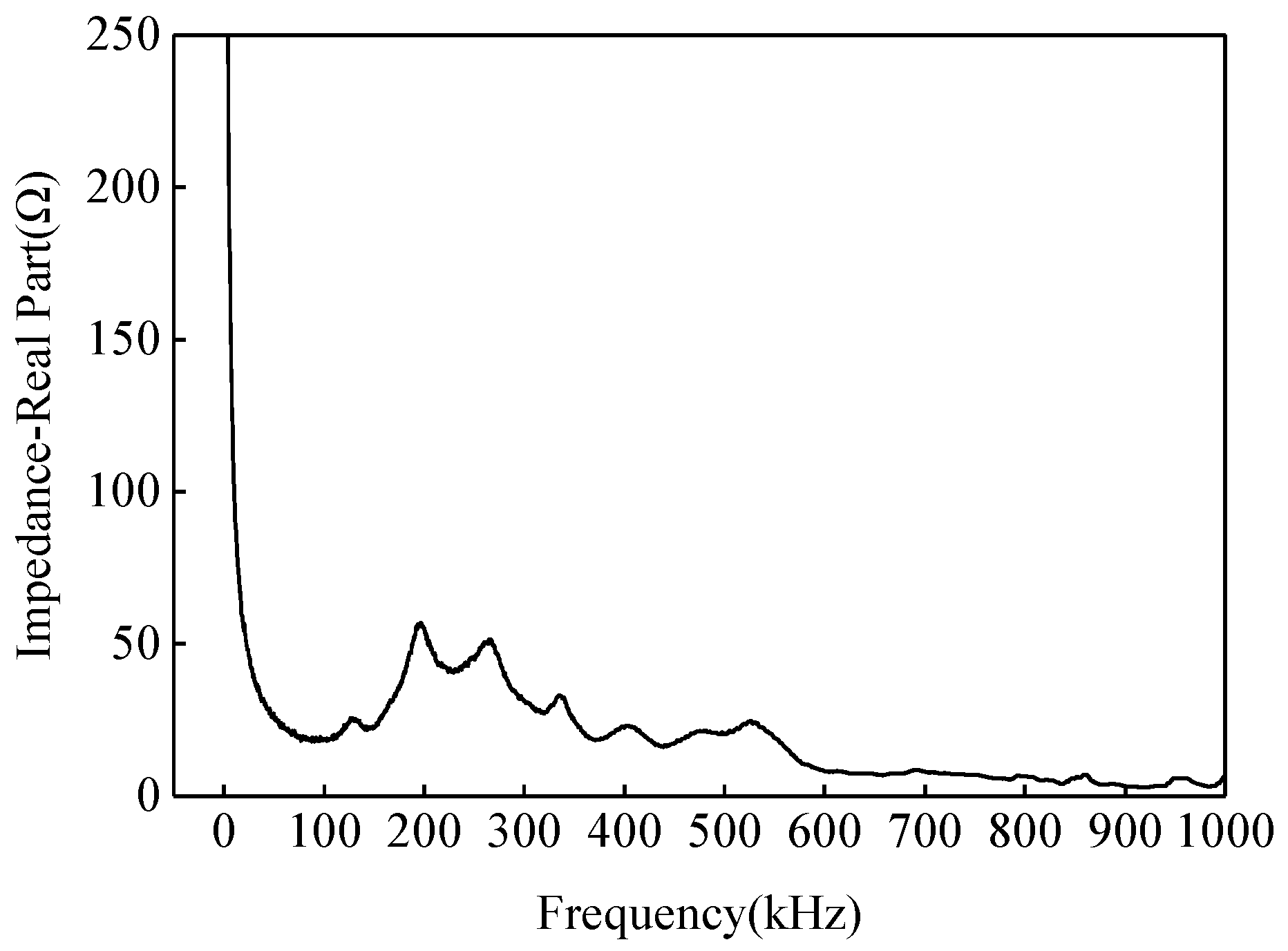
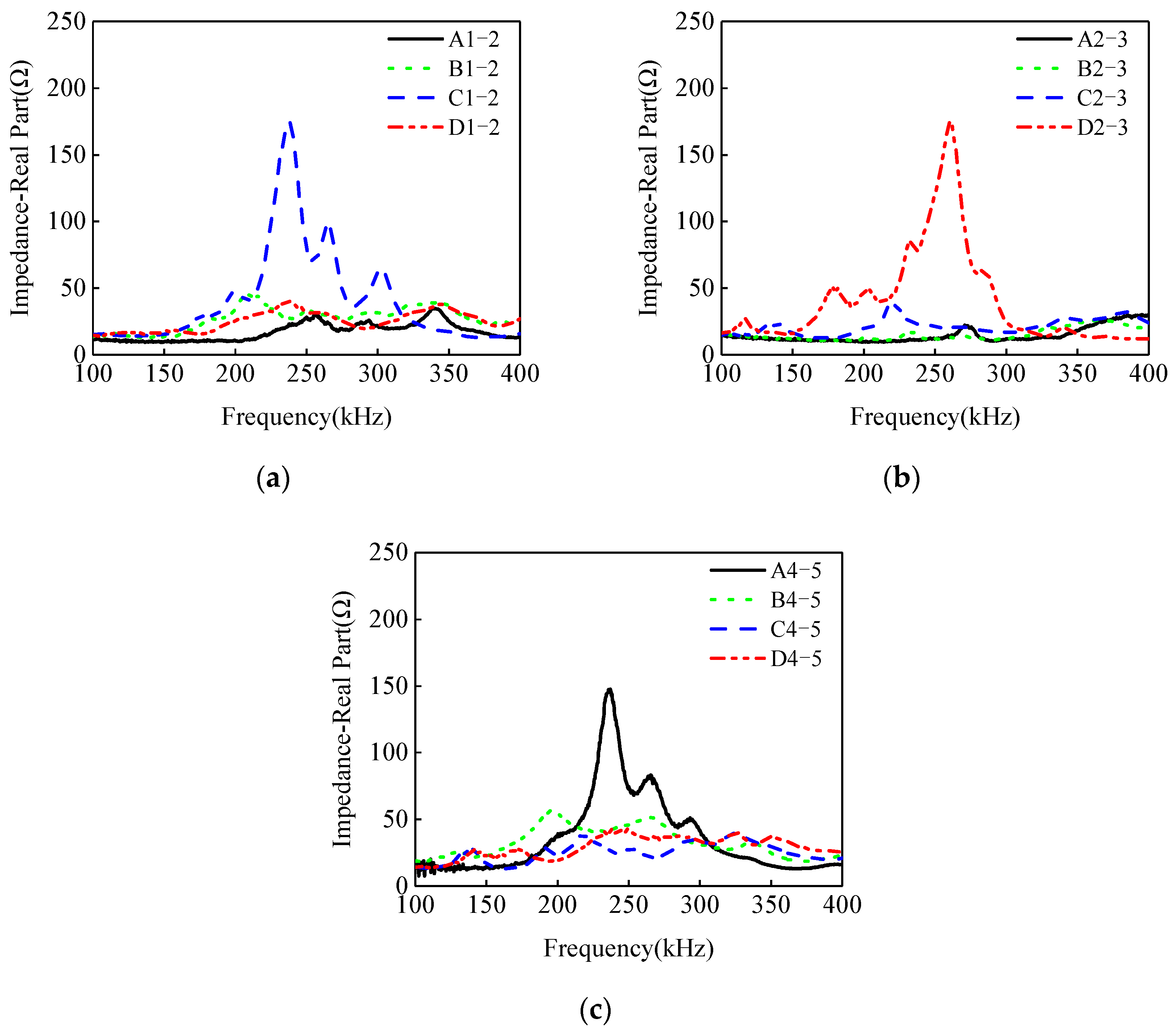
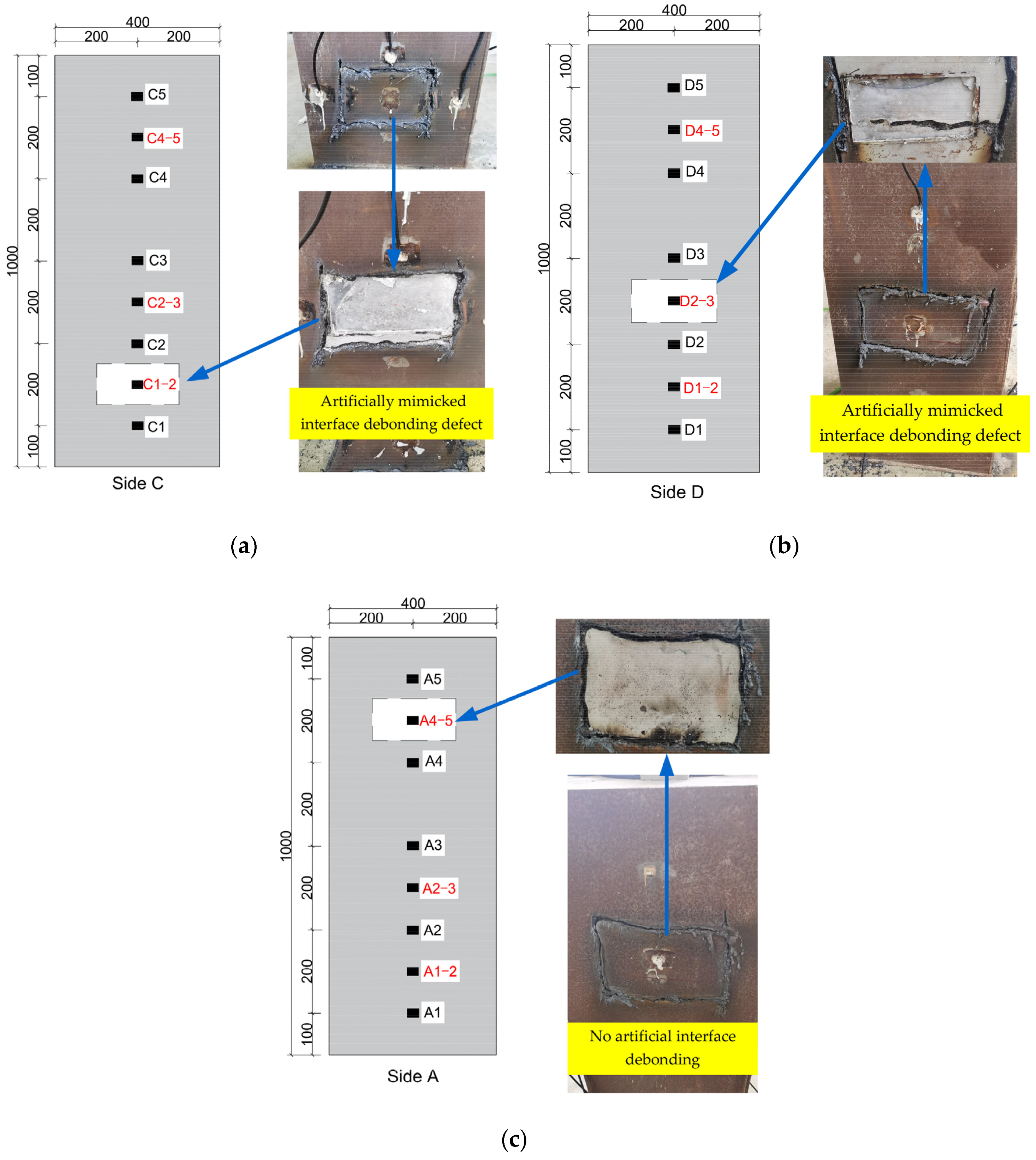
| Dimension | Material Parameters | ||
|---|---|---|---|
| Width | 10 mm | Complex dielectric constant | 1.77 × 10−8 F/m |
| Length | 15 mm | Complex Young’s modulus | 7.25 × 1010 N/m |
| Thickness | 0.3 mm | Piezoelectric constant | 185 PC/N |
| Dielectric loss factor | 1.5% | ||
Disclaimer/Publisher’s Note: The statements, opinions and data contained in all publications are solely those of the individual author(s) and contributor(s) and not of MDPI and/or the editor(s). MDPI and/or the editor(s) disclaim responsibility for any injury to people or property resulting from any ideas, methods, instructions or products referred to in the content. |
© 2024 by the authors. Licensee MDPI, Basel, Switzerland. This article is an open access article distributed under the terms and conditions of the Creative Commons Attribution (CC BY) license (https://creativecommons.org/licenses/by/4.0/).
Share and Cite
Liu, Q.; Xu, B.; Chen, G.; Ni, W.; Liu, Z.; Lin, C.; Zhuang, Z. Experimental Study on the Detection of the Existence and Location of Mimicked and Unexpected Interface Debonding Defects in an Existing Rectangular CFST Column with PZT Materials. Materials 2024, 17, 3154. https://doi.org/10.3390/ma17133154
Liu Q, Xu B, Chen G, Ni W, Liu Z, Lin C, Zhuang Z. Experimental Study on the Detection of the Existence and Location of Mimicked and Unexpected Interface Debonding Defects in an Existing Rectangular CFST Column with PZT Materials. Materials. 2024; 17(13):3154. https://doi.org/10.3390/ma17133154
Chicago/Turabian StyleLiu, Qian, Bin Xu, Genda Chen, Weilong Ni, Zhixun Liu, Chun Lin, and Zhiyou Zhuang. 2024. "Experimental Study on the Detection of the Existence and Location of Mimicked and Unexpected Interface Debonding Defects in an Existing Rectangular CFST Column with PZT Materials" Materials 17, no. 13: 3154. https://doi.org/10.3390/ma17133154





